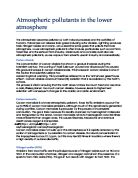Eni Ballauri
9A
Chemistry
Aerosols in Atmosphere
Environmental and Economical Impact
We have heard that greenhouse gases, mainly carbon dioxide, are leading to global warming. But, another factor has been identified that affects Earth’s atmosphere; aerosols. Aerosols are small particles or droplets in the atmosphere. Aerosol particles may be created by wind blowing over dusty regions, and also by the conversion into tiny particles of some of the gases emitted by plants and volcanoes.
Some aerosols remain in air only a few days, so they don’t have much time to travel away. But nevertheless, they affect our surrounding environment at the local and global levels. It is also recognised as a health problem, especially in regard to respiratory illness.
Atmospheric aerosols influence climate. They reflect the sunlight back to space, in a way that provides the gradual cooling of planet Earth. A professor in CU-Boulder’s Laboratory for Atmospheric and Space Physics, Toon, who has studied similar modification of clouds over the ocean and their effects, said that aerosol cloud may even cancel out greenhouse warming. During winter, in polar regions, polar stratospheric clouds form. This provides sites for chemical reactions to take place. These reactions can lead reaction of reactive chlorine, which destroys the ozone. Contrary, because of loosing the ozone layer, Earth will lose the protection from ultra violet rays. This leads to global warming. Volcanic gas is another factor that affects the environmental impact, realising quite big quantities of gases in the stratosphere which damages the environment in different ways. For instance, carbon dioxide promotes global warming, while on the other side causes global warming, acid rain, the ozone layer destruction and air pollution, also known as volcanic smog or shortly ‘vog’.

This is a preview of the whole essay
Peer Reviews
Here's what a star student thought of this essay
Quality of writing
#3# The language used could had been more scientific as in places it felt too conversational. Being informal in your writing style can in some places be an advantage but when writing a report it is better to keep the language formal and scientific. The fact that resources have been referenced is a higher level skill and shows an understanding of how scientific reports are meant to be written.
Level of analysis
#2# I feel that more research could be done so that claims could be substantiated with evidence. When you make a statement it is always important that if you can that you back it up with evidence as it gives the claims you are making more credit. The level of scientific language is appropriate for this level of study. The concluding paragraph could had been better with more of a round up of all the points made in the essay.
Response to question
#1# The student has answered the question well with care taken to answer both sides of the question, but I do feel that more time could had been taken to address the economical side of the argument. When given a question it is important to ensure that you answer every part of the question.








